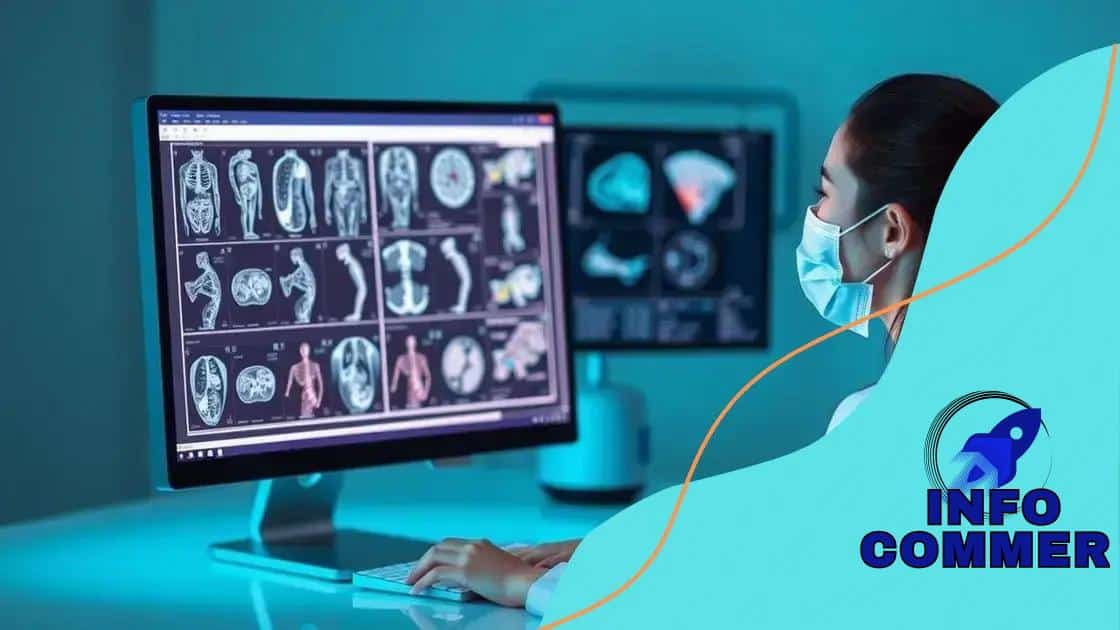AI-powered diagnostics for early disease detection

AI-powered diagnostics enhance healthcare by improving diagnostic accuracy, enabling early disease detection, and streamlining processes, but they face challenges such as data quality and regulatory compliance.
AI-powered diagnostics for early disease detection is changing the healthcare landscape. Imagine catching diseases before they become severe. Curious how this technology works? Let’s dive in!
Understanding AI-powered diagnostics
Understanding AI-powered diagnostics is essential for grasping how technology is transforming healthcare. These systems leverage data to provide insights that were once unattainable, enabling earlier diagnosis of diseases.
AI-powered diagnostics utilize algorithms and machine learning to analyze vast amounts of medical data. This approach allows for identifying patterns that the human eye might miss. For instance, AI can compare current patient data with historical data to spot inconsistencies that could indicate a health concern. The result? Improved accuracy in detecting diseases like cancer at earlier stages.
How AI Works in Diagnostics
The functioning of these diagnostics involves a few key processes. First, data is gathered from medical imaging, lab results, and patient history. Then, AI algorithms process this information, learning and adapting over time.
- Data collection: Gathering relevant health data is crucial.
- Machine learning: AI systems learn patterns from data.
- Diagnosis: Faster and more accurate insights emerge.
As AI systems continue to evolve, their capabilities grow alongside them. This technology is proving to be a game-changer in fields like radiology and pathology.
Benefits of AI in Healthcare
By utilizing AI-powered diagnostics, healthcare providers can offer more customized care. As AI sifts through data, it can highlight potential health risks specific to individuals. This ability leads to targeted interventions and personalized treatment plans.
Moreover, these systems can significantly reduce the workload of healthcare professionals. They can focus on complex cases, while AI handles routine diagnostics. Such efficiencies not only enhance patient care but also optimize healthcare resources overall.
The benefits of early disease detection
The benefits of early disease detection are extensive and can significantly improve health outcomes for patients. Identifying diseases at an early stage enhances the chances of successful treatment and recovery.
When diseases are detected early, it allows healthcare providers to implement intervention strategies sooner. This can lead to better management of the condition, minimizing the severity of symptoms and preventing complications. For example, catching cancer in its initial stages can drastically increase survival rates.
Key Advantages of Early Detection
Several key advantages highlight why early detection is crucial:
- Increased survival rates: Many diseases, particularly cancers, have higher survival rates when treated early.
- Cost-effectiveness: Early diagnosis often leads to less costly treatments compared to those needed for advanced diseases.
- Improved quality of life: Early detection usually means less invasive treatments, contributing to a better quality of life for patients.
- Personalized treatment: Knowing a condition early allows for tailored treatment plans that fit the patient’s needs.
Moreover, early disease detection helps in reducing the overall burden on the healthcare system. When diseases are caught early, it reduces the need for extensive hospital stays and emergency interventions, allowing healthcare professionals to allocate resources more effectively.
The role of technology in enhancing early detection cannot be overstated. Innovative tools such as AI-powered diagnostics are revolutionizing how we identify health issues. These technologies can analyze data faster and sometimes more accurately than human practitioners, further improving detection rates.
How AI enhances diagnostic accuracy

How AI enhances diagnostic accuracy is a crucial topic in modern healthcare. With the rise of advanced technology, medical professionals can now rely on AI to assist in making more precise diagnoses.
AI systems analyze vast amounts of patient data quickly and efficiently. By examining medical histories, lab results, and imaging studies, AI can identify patterns that may be overlooked by human practitioners. This ability significantly improves diagnostic accuracy, enabling quicker and more reliable health assessments.
Mechanisms of AI in Diagnostics
AI uses algorithms and machine learning to interpret complex data sets. These technologies train on historical data, learning how to predict outcomes based on similar cases. Here are some ways AI boosts diagnostic power:
- Image recognition: AI excels at analyzing medical images, such as X-rays and MRIs, to detect anomalies.
- Predictive analytics: AI can foresee potential health issues based on patient history.
- Real-time data processing: AI systems can evaluate incoming data instantaneously, providing immediate feedback to clinicians.
This advancement leads to quicker diagnoses, allowing treatments to begin sooner. For example, AI has shown remarkable success in identifying early signs of diseases like Alzheimer’s and cancers, where timing is critical.
The integration of AI in diagnostics does not only enhance accuracy but also helps reduce human error. Physicians can rely on AI insights to support their decisions, resulting in fewer misdiagnoses and better patient outcomes. Furthermore, as AI continues to learn and adapt, its diagnostic capabilities grow progressively more robust.
Real-world applications of AI in healthcare
Real-world applications of AI in healthcare are transforming how medical professionals deliver care. These advanced technologies are already making significant impacts across many areas of healthcare.
One of the most notable applications is in medical imaging. AI-assisted tools can analyze X-rays, MRIs, and CT scans quickly and accurately, identifying conditions like fractures or tumors more effectively than human eyes alone. This capability allows doctors to focus on decision-making and patient care rather than spending excessive time on image analysis.
AI in Predictive Analytics
Another crucial area where AI shines is in predictive analytics. By examining large datasets, AI systems can predict patient outcomes based on trends and patterns. For instance, they can identify which patients are at higher risk for certain diseases, allowing for early intervention.
- Risk assessments: AI helps determine which patients may develop chronic conditions.
- Emergency response: AI can forecast patient inflow in emergency rooms based on historical data.
- Resource allocation: Hospitals can manage staff and equipment more efficiently by predicting patient needs.
The integration of AI is also evident in telemedicine. AI algorithms analyze patient data to provide personalized recommendations during virtual consultations. This approach keeps patients engaged and informed about their health while receiving care remotely.
Furthermore, AI applications extend to drug development, significantly speeding up the process of moving from research to market. Machine learning helps scientists identify potential compounds and predict how they will interact in the body. This innovation not only shortens development time but also enhances the safety and efficacy of new medications.
Challenges in implementing AI diagnostics
Challenges in implementing AI diagnostics are significant and can impact how effectively these technologies are integrated into healthcare systems. Despite the advantages, several obstacles remain in the path to successful adoption.
One of the primary challenges is the need for high-quality data. AI systems require large datasets to learn and improve their diagnostic accuracy. If the data is incomplete, biased, or not representative of the population, the AI may deliver inaccurate results. This means data collection and management are crucial components of implementing AI solutions.
Regulatory and Ethical Considerations
Another major hurdle involves regulatory and ethical issues surrounding AI in healthcare. Organizations must navigate complex regulations to ensure compliance with healthcare laws. Transparency about how AI systems make decisions is essential, especially when these decisions affect patient care.
- Data privacy: Protecting patient information is a top priority, requiring stringent safeguards.
- Bias in algorithms: AI systems can unintentionally perpetuate biases if not carefully monitored.
- Accountability: Determining who is responsible for errors in diagnosis needs clarity.
Additionally, educating healthcare professionals on how to use AI tools effectively is vital. Some providers may be hesitant to adopt new technologies due to lack of understanding or trust. Training programs should be developed to help staff feel confident in using AI diagnostics in their workflow.
Lastly, the integration process can be resource-intensive, requiring time and money. Healthcare systems must be prepared for the changes in infrastructure and workflow that accompany the implementation of AI technologies. Proper planning and financial investment are necessary to realize the benefits of AI-powered diagnostics.
FAQ – Frequently Asked Questions about AI-powered Diagnostics in Healthcare
What are the main benefits of AI in healthcare diagnostics?
AI enhances diagnostic accuracy, enables early disease detection, and streamlines medical processes, ultimately improving patient outcomes.
How does AI improve diagnostic accuracy?
AI analyzes large datasets quickly, identifying patterns and anomalies that might be missed by human practitioners, leading to more reliable diagnostics.
What challenges come with implementing AI diagnostics?
Challenges include the need for high-quality data, regulatory compliance, and the necessity for training healthcare staff on new AI tools.
Are there real-world applications of AI in healthcare?
Yes, AI is used in medical imaging, predictive analytics, telemedicine, and drug development, among other areas.





